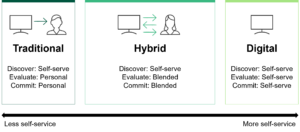Digital buying and self-service are everywhere. In all buying stages, B2B buyers use tools to complete tasks and purchases on their own. Reassuringly, they still value interactions with sales reps and product experts. However, sales teams haven’t kept up with the digital practices of buyers – leading to thinner pipelines, longer sales cycles, and greater customer frustration.
Digital selling and buyer enablement are top of mind for chief revenue officers (CRO) and chief sales officers (CSO). Forrester’s B2B Sales Survey, 2023 reveals that 63% of sales leaders said digital buying behaviors would have a significant impact on their organization in the next two years. Yet only 37% said digitizing the buyer’s journey is a top priority. It’s time to get serious about self-service. Our latest report, The Rise Of Self-Service Buying, further highlights how this trend affects prospect engagement along a spectrum of buying scenarios.

Self-Service Buying Is Permanent
Technology, demographics, and dispersed purchasing teams have permanently transformed business buying. Today, buyers use self-service tools to perform tasks that once required human interaction. Simply stated, they buy on their own terms and timelines. In contrast, B2B selling has not evolved as quickly. And too little of the evolution is focused on selling to customers based on self-serve needs. Sales leaders must address three core drivers of self-directed activity:
- Younger buyers. First, Millennial and Gen Z buyers are large, digitally-savvy generations. They adopt self-service at higher rates and are influential purchasing decision-makers.
- Technology tools. Next, the tools and information buyers need to complete self-serve tasks and purchase transactions are readily available. And they will forever be on-demand.
- Buying groups. Finally, purchasing happens in ad hoc buying groups throughout a company. Buyers use self-service to complete tasks on top of their everyday job duties.
Digital Buying Requires Digital Selling
The frequency, volume, and purchase sizes of B2B self-service activity continue to rise. In addition, self-guided actions are now present across lifecycle stages, product types, price points, and channels. Therefore, all go-to-market (GTM) teams—sales, marketing, product, customer success, and partner—must help buyers purchase on their own. B2B companies need a new playbook. If buyers buy digitally, then sellers must sell digitally. Interestingly, companies like SugarCRM now offers tips on how to prepare for self-service buying. In the report, we stress that leaders must:
- Refresh customer tools. Refresh the self-service toolkit you offer customers. For example, use pre-recorded webinars, self-guided product demos, on-demand configurators and quotes, and other online resources to help buyers complete important tasks on their own.
- Combine buying signals. When buyers self-serve, sellers struggle to see the activity. So, improve visibility by combining digital and personal buying signals. You’ll also need shared data with an integrated marketing and sales tech stack to achieve this.
- Adopt hybrid selling. All roads no longer lead to the seller. Instead, they lead to the best source for buyers to complete tasks. To address the space between traditional and all-digital purchases, use hybrid selling techniques that meet the workflow needs of buyers.
- Do more work together. GTM teams must stop blaming each other and start working pipeline together. Buying groups need supportive selling groups. Accordingly, introduce quarterly, cross-functional cadences to not only drive revenue but also meet the self-serve and personal buying needs of prospects.
- Address related purchasing functions. Buying groups use self-service to buy products just like teams in related purchasing functions do. Support inventory planning, sourcing, procurement, and supplier management teams with similar digital tools.
Self-service buying is a wake-up call for B2B sales. Indeed, it’s a stealthy disruptor go-to-market teams can no longer ignore. Although easy to miss, it is the common ingredient fueling the growth of web sales, e-commerce, in-product purchases, online marketplaces, and e-procurement portals. In the past, we have rightfully focused on helping sellers sell. Now with self-service, we must also focus on helping buyers buy. Buyers want to buy online, so let them. Better yet, enable them!
Read The Rise Of Self-Service Buying report (client access required) and schedule a guidance session to discuss how you can improve your B2B sales approach and meet buyers where they are.








